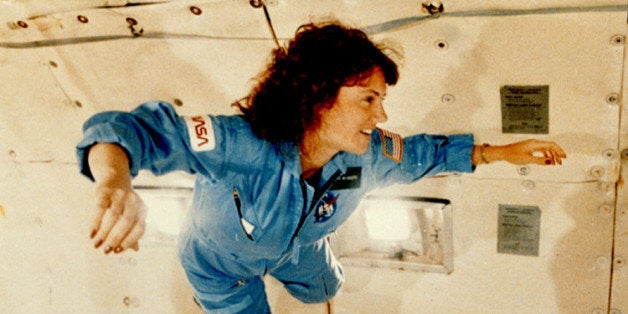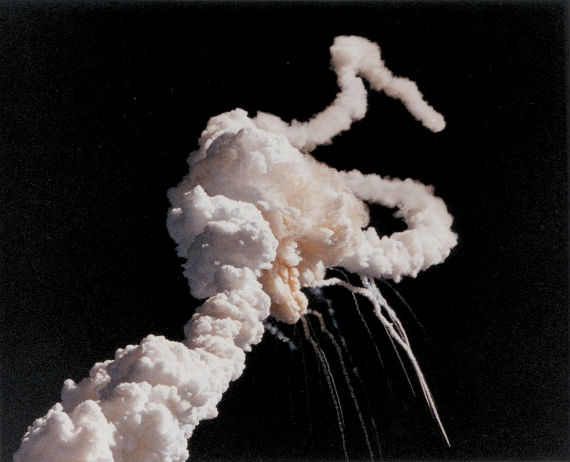
In the January 28, 1986 Challenger shuttle accident, two technologies -- aerospace and television -- flexed their muscles and revealed their tragic flaws.
The same powerful thrust of fuel and engines that promised to bring glory to NASA's "Teacher-in-Space" Christa McAuliffe and the other members of the shuttle crew also sealed their fate, leaving them ten miles up, in an inferno, without protection or parachutes.
Similarly, the media blitz that thrust Christa into our lives left our emotions up in the air, raw and exposed to the elements.
Most of us never met Christa or her family. Yet we found ourselves dwelling on the fate of her children and husband, her parents and her Concord, New Hampshire, students. Christa McAuliffe's death continues to overshadow those of the other six astronauts, just as the shuttle accident eclipsed most of the other news events of 1986.
Of course, our sense of intimacy with Christa was no accident. Realizing that television deals better with personalities than with the abstract idea of "space exploration," NASA decided to involve us in its next shuttle flight by focusing publicity on a single person, the first civilian, someone like you and me.
Christa was chosen to be our representative, the first extraordinary ordinary person to travel into space. Surely, her TV-game-show-like enthusiasm played a part in her selection. And through the media attention, NASA and the press sent her into an orbit of celebrity. The six other astronauts were kept out of the television picture.
NASA knew that television is unlike any other medium in that it allows millions of people to see and experience the same person or event at the same moment. Yet along with the massive size of its shared arena, television is a close-up medium that fosters intimacy and involvement. With television, millions of us came to feel that we "knew" and had "met" Christa, her family, and her students. We saw Christa's smiles and heard her giggles. We experienced her in a way that, before televisual media, we shared only with people we knew from face-to-face interaction.
NASA had also planned to harness the power of television in the shuttle send-off and, later, for two in-flight lessons. In 1986, only television could allow children in schools and adults at work, parents at home and executives in boardrooms, prisoners in cells and a president in the oval office, to witness an event "together."
But then everything went wrong. Neither the technology of physical force nor of information transmission proved flawless. Christa's spacecraft could not withstand the explosion of fuel, and television also became fully engulfed in the heat of grief and disbelief.
On takeoff day, television accomplished the very opposite of what NASA had planned for it. Millions of children were required to watch the takeoff in their schools, in part to demonstrate the miracles of science and, ultimately, to reinforce the authority of teachers and the importance of educational curricula. Instead, students saw the bewilderment of their teachers and learned of the dangerous fallibility of science.

Challenger explosion.
Photo from Wikipedia Commons
Television's immediacy was meant to involve us all in a pageant certifying NASA as a worthy beneficiary of continued and increasing funding. Instead, television revealed NASA's lack of control over the situation. TV's immediacy showed us an explosion that had not yet been seen by NASA's narrator for the takeoff, who was still looking at his instruments. And television's moment-by-moment coverage -- particularly CNN's then-innovative live satellite images -- heightened our awareness of the length of the delay between the accident and NASA's first public comment on it.
NASA had no doubt hoped that the very concrete, personal dimension of Christa's flight would overshadow in the public mind the more abstract debate over the relative usefulness of shuttles versus disposable space vehicles. Instead, the televised disaster magnified the degree of human risk and blotted out the overall success of the shuttle program.
The televised "teacher in space" was to become another Reagan administration publicity coup, an event that would give the image of leadership in support for education without any actual increase in educational funding. But television's speed undermined Reagan's image of leadership too. When we turned quickly to the President for some guidance, we discovered that he hadn't even watched the takeoff live, that millions of us average citizens already knew what our leader did not.
What was to have been both good politics and good television became instead an exposure of the dangerous symbiosis of government and news agencies, caught in the webs of their own routines and desires. The networks, enjoying their access to dramatic images, allowed themselves to be duped into believing that shuttle takeoffs were safe and routine. NASA, dependent on the news media for publicity, allowed itself to feel the heat of not keeping the media waiting any longer after several delays -- despite the freezing weather and the warnings of the engineers at contractor Morton Thiokol that their rocket booster's O-rings could fail from the cold. The President's State of the Union address was scheduled for that night, and NASA wanted the planned publicity plug. The disaster gave NASA a less enviable sort of publicity and delayed the President's State of the Union address for a week.
The many comparisons notwithstanding, the trauma surrounding the explosion of the Challenger was different from the grief surrounding the death of John F. Kennedy, Martin Luther King Jr., and other beloved media figures. For millions of children and adults witnessed the shuttle accident as it happened, before it was channeled through authorities or described to us by journalists. Only retroactively, did we realize we had witnessed death. The ambiguity of the raw visual experience created long moments of bewilderment and a vacuum of understanding and authority that has been difficult for many of us to forget.
Television, which gave us our relationship with Christa, felt obligated to play the major role in the mourning. Her fellow astronauts were dutifully named and pictured, but the coverage dwelled on Christa. Other, more remote -- and perhaps more important -- news events disappeared.
In death, McAuliffe became larger than life. Her name itself a variation of Christ's, she became an ambiguous, but all-purpose symbol of innocence, one who had been chosen to ascend to the heavens in our place, and then return to dwell among us. But she died instead for our sins of technological hubris, her mission unfulfilled. And television was there again to report on the investigation of fault, the search for a Judas. Because NASA knew that few people could stand the thought of Christa and the other astronauts plunging toward the ocean alive, rather than having been killed instantly in the initial explosion, it suppressed this information until months after the public attention had subsided.
Beneath the since-uncovered tangle of politics and mismanagement and lies, our contrived media relationship with Christa McAuliffe remains emotionally powerful and real, perhaps unique in its brevity and intensity. Indeed, the same, single event that was to establish McAuliffe's importance -- the shuttle takeoff -- was transformed instead into a moment of tragedy and death.
The final and saddest irony is that the accident not only robbed us of a living Christa, but also robbed Christa of the very accomplishment that might have justified all the media attention she had received.